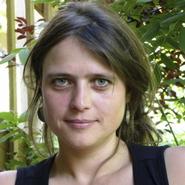
For many Americans, radiation exposure is often linked to cancer treatment or atomic fallout. For villagers living in and around Semipalatinsk, however, exposure to radioactivity is a part of everyday life. Semipalatinsk, nicknamed “the Polygon”due to its cartographic shape, is located in east Kazakhstan and is the world’s largest nuclear test site (18,000 square kilometers).
Medical Anthropologist Magdalena Stawkowski, the MacArthur Nuclear Security Postdoctoral Fellow at the Center for International Security and Cooperation, spent 20 months living in the small rural village of Koyan, just outside of the “official” borders of the Polygon (though those are neither well designated nor defined). The Levitt Public Affairs Center invited Stawkowski to the Hill on Oct. 7 to speak about the lifestyle and health of residents in the Polygon.
Stawkowski explained that Koyan residents are Kazakhs, a Turkic people who have lived in the steppe since the 15th century and “now navigate pastoral life in a site that was home to 460 nuclear tests,” the last of which was just two decades ago. Stawkowski said she began her research intending to study the diaspora Polish community of the area, but instead became fascinated with the nuclear issue and switched topics.
Although humans had previously been thought of as relatively resilient to nuclear radiation, based on survivors from Hiroshima and Nagasaki, a 2012 study of butterfly populations near the Fukushima disaster site demonstrated “irreparable and heritable gene damage resulting in devastating intergenerational effects.” This suggests that humans may also be susceptible to passing on radioactively altered genes, which could have global consequences considering “250-270,000 people are children of irradiated parents.”
Stawkowski recommended the 2010 documentary, After the Apocalypse, which details the legacy of radioactive fallout for Kazakhstan, while specifically focusing on the residents of Semipalatinsk as models of the highly devastating effects of nuclear radiation.
Despite such evidence, the government’s official stance is that “exposure is minimal and poses no threat to human health;” in fact, the Polygon is being reopened for agriculture and herding. The pastoral lifestyle of residents often makes them “heralded as the original Kazakhs, [and thus they] see themselves as national members who, although victims, are also generationally adapted and eager to turn Kazakhstan into the biggest resource farm in the world.”
Unfortunately, wealthy Kazakhs and Uzbeks are buying enormous areas of land in the Polygon for very low prices, then ‘employing’ the local peasants with payments of food and shelter in exchange for work, effectively creating a system of indentured servitude. Furthermore, these foodstuffs are deemed to be safe without being adequately tested and are distributed throughout much of the country and even the region, as are byproducts from the mines, such as coal and uranium.
Residents of the Polygon are typically destitute poor, who do not have the option of leaving their pastoral lifestyle for meager work in overcrowded urban centers. After the dissolvement of the USSR, residents in the Polygon were left in a “zone of abandonment,” no longer employed by the state or recipients of welfare programs. This left the communities to fend for themselves, which they have done, despite high rates of anemia, bone pain and irritated skin, and a doubled likelihood of developing cancer.
Although Semipalatinsk residents sometimes feel the effects of radiation exposure, the vast majority of individuals are phenotypically normative, lacking tumors and birth defects. Because of this, Stawkowski explained, “residents consider themselves adapted to their radioactive environment, believing that they are safe due to constant low-dose radiation.” Indeed, the residents themselves often cite the lack of “humanoid mutants” as proof of their genetic adaptation.
These communities have adapted to constant radiation such that venturing out of the Polygon for too long causes individuals to experience headaches, stomachaches and nose bleeds. Beyond this, Stawkowski also mentioned that residents prefer not to leave because they would “be subject to systematic marginalization in urban communities, and ostracized by medical professionals who view them as mutants.” Yet, “the residents of Koyan are part of the mutant ecology, and consider themselves pieces of the new ecosystem as much as any other organism.”
Stawkowski explained how these residents have no real option of leaving, due to economic, physical, and social constraints, but also have no delusions about the safety of their lifestyle for outsiders, fully acknowledging the poisonous nature of their food, livestock and even air. Yet when it comes to their own health, “they choose to believe that they have sufficiently adapted to this environment because they have, in a certain sense, resigned to their condition.”
Stawkowski commented on the apathetic acceptance of tragedy she witnessed in the community, whether due to suicide, cancer or accident. She noticed a “certain sense of freedom and self-reliance,” mixed with a pervasive fatalism, and noted how the self-identified “Polygon people” have employed Sartre’s “bad faith” in order to continue living their day-to-day life.
Posted October 8, 2015
